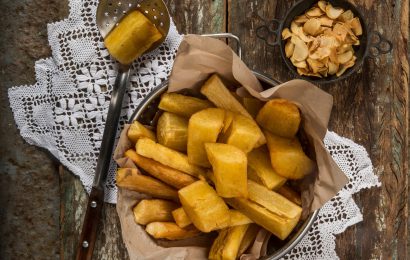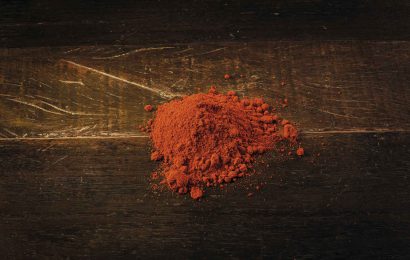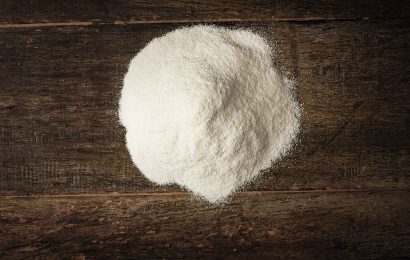Without this ingredient, at least two classics preparations served on the Brazilian tables for breakfast or afternoon snack would not exist: the tempting and crunchy Biscoito de polvilho and Pão de queijo, a manioc starch and cheese roll born in Minas Gerais to conquer the country. Extracted by decantation from the liquid squeezed out of the hydrated grated manioc, it can be doce (“sweet,” that is, the starch is dried immediately after being separated from the liquid – known as tapioca / manioc / cassava starch / flour in English, not to be confused with instant tapioca granules or puffed tapioca flakes) or azedo (“sour”, that is, the starch is left to ferment for up to twenty days before being dried – available outside Brazil usualy as an import). While still moist, polvilho doce is called goma, and used to prepare the crepe-like bread known as Tapioca or Beiju in Portuguese by simply passing it through a sieve onto a hot skillet. With a more acidic flavor, polvilho azedo is used to make biscoitos and pão de queijo – although some recipes also include polvilho doce. In Mato Grosso do Sul, polvilho doce is also the ingredient used to prepare Chipa, a hybrid of biscoito and pão de queijo, horseshoe-shaped, and also known as “Paraguayan pão de queijo,” as the recipe came from the neighboring country.
Privacy Overview
This website uses cookies to improve your experience while you navigate through the website. Out of these, the cookies that are categorized as necessary are stored on your browser as they are essential for the working of basic functionalities of the website. We also use third-party cookies that help us analyze and understand how you use this website. These cookies will be stored in your browser only with your consent. You also have the option to opt-out of these cookies. But opting out of some of these cookies may affect your browsing experience.
Advertisement cookies are used to provide visitors with relevant ads and marketing campaigns. These cookies track visitors across websites and collect information to provide customized ads.
Analytical cookies are used to understand how visitors interact with the website. These cookies help provide information on metrics the number of visitors, bounce rate, traffic source, etc.
| Cookie | Duration | Description |
|---|---|---|
| cookielawinfo-checkbox-analytics | 11 months | This cookie is set by GDPR Cookie Consent plugin. The cookie is used to store the user consent for the cookies in the category "Analytics". |
Functional cookies help to perform certain functionalities like sharing the content of the website on social media platforms, collect feedbacks, and other third-party features.
| Cookie | Duration | Description |
|---|---|---|
| cookielawinfo-checkbox-functional | 11 months | The cookie is set by GDPR cookie consent to record the user consent for the cookies in the category "Functional". |
Necessary cookies are absolutely essential for the website to function properly. These cookies ensure basic functionalities and security features of the website, anonymously.
| Cookie | Duration | Description |
|---|---|---|
| cookielawinfo-checkbox-necessary | 11 months | This cookie is set by GDPR Cookie Consent plugin. The cookies is used to store the user consent for the cookies in the category "Necessary". |
| viewed_cookie_policy | 11 months | The cookie is set by the GDPR Cookie Consent plugin and is used to store whether or not user has consented to the use of cookies. It does not store any personal data. |
Other uncategorized cookies are those that are being analyzed and have not been classified into a category as yet.
| Cookie | Duration | Description |
|---|---|---|
| cookielawinfo-checkbox-others | 11 months | This cookie is set by GDPR Cookie Consent plugin. The cookie is used to store the user consent for the cookies in the category "Other. |
Performance cookies are used to understand and analyze the key performance indexes of the website which helps in delivering a better user experience for the visitors.
| Cookie | Duration | Description |
|---|---|---|
| cookielawinfo-checkbox-performance | 11 months | This cookie is set by GDPR Cookie Consent plugin. The cookie is used to store the user consent for the cookies in the category "Performance". |



